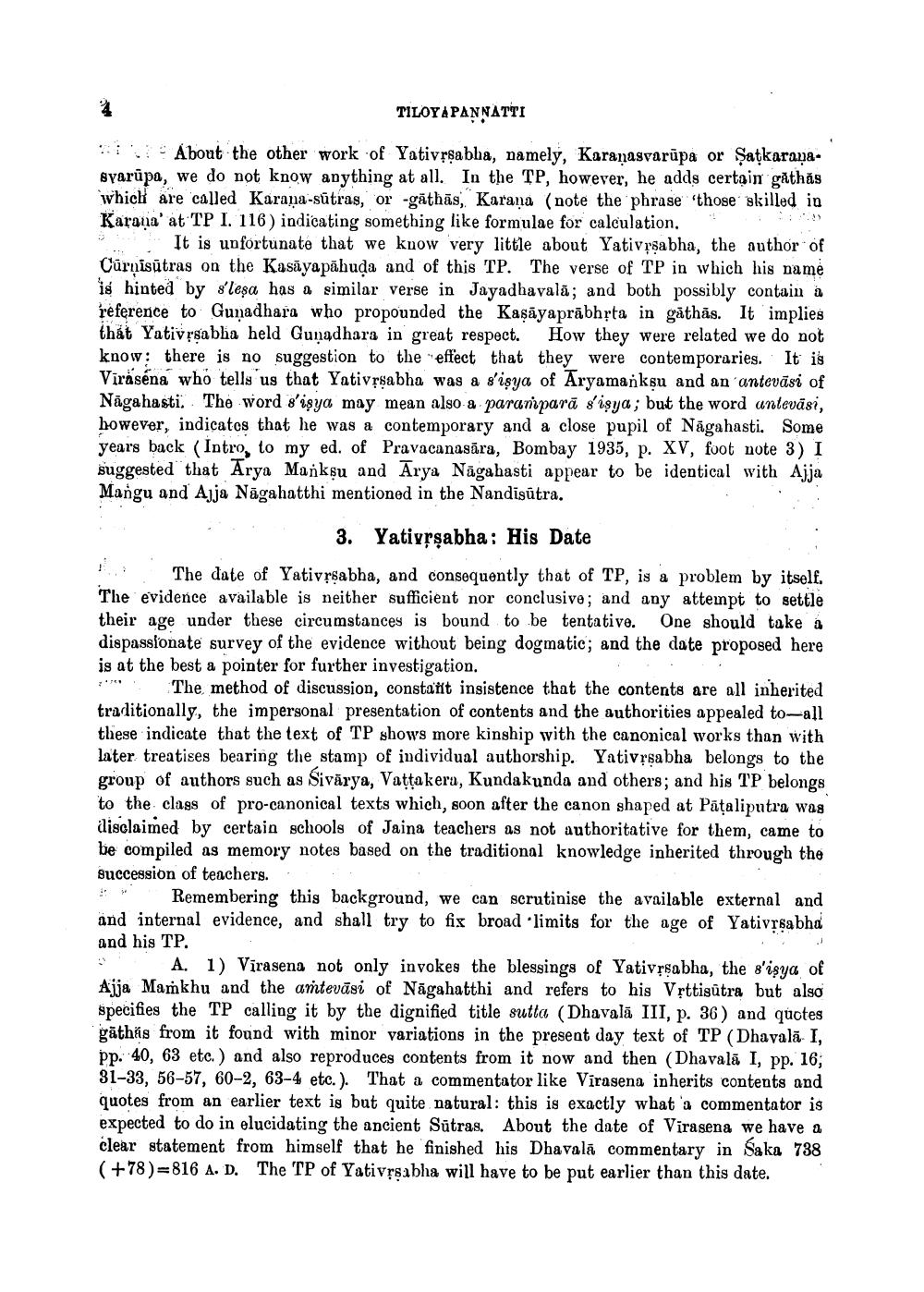Book Title: Introduction Tiloya Pannatti Author(s): A N Upadhye Publisher: A N Upadhye View full book textPage 4
________________ TILOYAPANNATTI About the other work of Yativrsabha, namely, Karanasvarūpa or Satkaraṇa. syarūpa, we do not know anything at all. In the TP, however, he adds certain gåthås which are called Karana-sūtras, or -gāthās, Karana (note the phrase "those skilled in Karana' at TP I. 116 ) indicating something like formulae for calculation. I It is unfortunate that we know very little about Yativrsabha, the author of Cūrnisūtras on the Kasāyapāhuda and of this TP. The verse of TP in which his name is hinted by s'lesa has a similar verse in Jayadhavală; and both possibly contain a reference to Gunadhara who propounded the Kaşāyaprābhịta in gathās. It implies thát Yativrsabha held Gunadhara in great respect. How they were related we do not know: there is no suggestion to the effect that they were contemporaries. It is Virásena who tells us that Yativrsabha was a s'isya of Aryamajkşu and an 'antevāsi of Nägahasti. The word s'isya may mean also a paramparā s'isya; but the word untevāsi, however, indicates that he was a contemporary and a close pupil of Nägahasti. Some years back (Intro, to my ed. of Pravacanasāra, Bombay 1935, p. XV, foot note 3) I suggested that Arya Majkşu and Arya Nāgahasti appear to be identical with Ajja Mangu and Ajja Nāgahatthi mentioned in the Nandisutra. 3. Yativrşabha: His Date ! The date of Yativrsabha, and consequently that of TP, is a problem by itself. The evidence available is neither sufficient nor conclusive; and any attempt to settle their age under these circumstances is bound to be tentative. One should take a dispassionate survey of the evidence without being dogmatic; and the date proposed here is at the best a pointer for further investigation. ***** The method of discussion, constañt insistence that the contents are all inherited traditionally, the impersonal presentation of contents and the authorities appealed to-all these indicate that the text of TP shows more kinship with the canonical works than with later treatises bearing the stamp of individual authorship. Yativrsabha belongs to the group of authors such as Sivārya, Vattakera, Kundakunda and others; and his TP belongs to the class of pro-canonical texts which, soon after the canon shaped at Pāțaliputra was disclaimed by certain schools of Jaina teachers as not authoritative for them, came to be compiled as memory notes based on the traditional knowledge inherited through the succession of teachers. Remembering this background, we can scrutinise the available external and and internal evidence, and shall try to fix broad limits for the age of Yativrsabha and his TP. A. 1) Virasena not only invokes the blessings of Yativrsabha, the s'isya of Ajja Mamkhu and the artevāsi of Nāgahatthi and refers to his Vittigůtra but also specifies the TP calling it by the dignified title sutta (Dhavală III, p. 36) and quotes gāthås from it found with minor variations in the present day text of TP (Dhayalā I, pp. 40, 63 etc.) and also reproduces contents from it now and then (Dhavalā I, pp. 16, 31-33, 56-57, 60-2, 63-4 etc.). That a commentator like Virasena inherits contents and quotes from an earlier text is but quite natural: this is exactly what a commentator is expected to do in elucidating the ancient Sūtras. About the date of Virasena we have a clear statement from himself that he finished his Dhavală commentary in Saka 738 (+78)=816 A. D. The TP of Yativrsabha will have to be put earlier than this date. 31-35, an earlier text is but quite datuage About the date of in Saka 738Page Navigation
1 2 3 4 5 6 7 8 9 10 11 12 13
